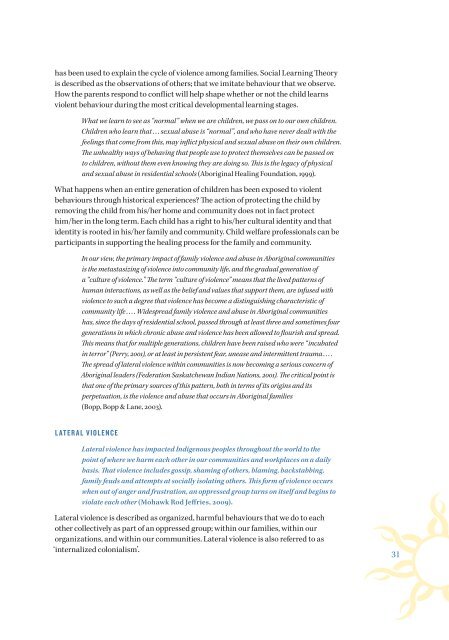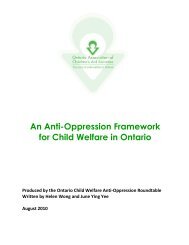English - Ontario Association of Children's Aid Societies
English - Ontario Association of Children's Aid Societies
English - Ontario Association of Children's Aid Societies
You also want an ePaper? Increase the reach of your titles
YUMPU automatically turns print PDFs into web optimized ePapers that Google loves.
has been used to explain the cycle <strong>of</strong> violence among families. Social Learning Theory<br />
is described as the observations <strong>of</strong> others; that we imitate behaviour that we observe.<br />
How the parents respond to conflict will help shape whether or not the child learns<br />
violent behaviour during the most critical developmental learning stages.<br />
What we learn to see as “normal” when we are children, we pass on to our own children.<br />
Children who learn that . . . sexual abuse is “normal”, and who have never dealt with the<br />
feelings that come from this, may inflict physical and sexual abuse on their own children.<br />
The unhealthy ways <strong>of</strong> behaving that people use to protect themselves can be passed on<br />
to children, without them even knowing they are doing so. This is the legacy <strong>of</strong> physical<br />
and sexual abuse in residential schools (Aboriginal Healing Foundation, 1999).<br />
What happens when an entire generation <strong>of</strong> children has been exposed to violent<br />
behaviours through historical experiences The action <strong>of</strong> protecting the child by<br />
removing the child from his/her home and community does not in fact protect<br />
him/her in the long term. Each child has a right to his/her cultural identity and that<br />
identity is rooted in his/her family and community. Child welfare pr<strong>of</strong>essionals can be<br />
participants in supporting the healing process for the family and community.<br />
In our view, the primary impact <strong>of</strong> family violence and abuse in Aboriginal communities<br />
is the metastasizing <strong>of</strong> violence into community life, and the gradual generation <strong>of</strong><br />
a “culture <strong>of</strong> violence.” The term “culture <strong>of</strong> violence” means that the lived patterns <strong>of</strong><br />
human interactions, as well as the belief and values that support them, are infused with<br />
violence to such a degree that violence has become a distinguishing characteristic <strong>of</strong><br />
community life . . . . Widespread family violence and abuse in Aboriginal communities<br />
has, since the days <strong>of</strong> residential school, passed through at least three and sometimes four<br />
generations in which chronic abuse and violence has been allowed to flourish and spread.<br />
This means that for multiple generations, children have been raised who were “incubated<br />
in terror” (Perry, 2001), or at least in persistent fear, unease and intermittent trauma . . . .<br />
The spread <strong>of</strong> lateral violence within communities is now becoming a serious concern <strong>of</strong><br />
Aboriginal leaders (Federation Saskatchewan Indian Nations, 2001). The critical point is<br />
that one <strong>of</strong> the primary sources <strong>of</strong> this pattern, both in terms <strong>of</strong> its origins and its<br />
perpetuation, is the violence and abuse that occurs in Aboriginal families<br />
(Bopp, Bopp & Lane, 2003).<br />
LATERAL VIOLENCE<br />
Lateral violence has impacted Indigenous peoples throughout the world to the<br />
point <strong>of</strong> where we harm each other in our communities and workplaces on a daily<br />
basis. That violence includes gossip, shaming <strong>of</strong> others, blaming, backstabbing,<br />
family feuds and attempts at socially isolating others. This form <strong>of</strong> violence occurs<br />
when out <strong>of</strong> anger and frustration, an oppressed group turns on itself and begins to<br />
violate each other (Mohawk Rod Jeffries, 2009).<br />
Lateral violence is described as organized, harmful behaviours that we do to each<br />
other collectively as part <strong>of</strong> an oppressed group; within our families, within our<br />
organizations, and within our communities. Lateral violence is also referred to as<br />
‘internalized colonialism’.<br />
31

















